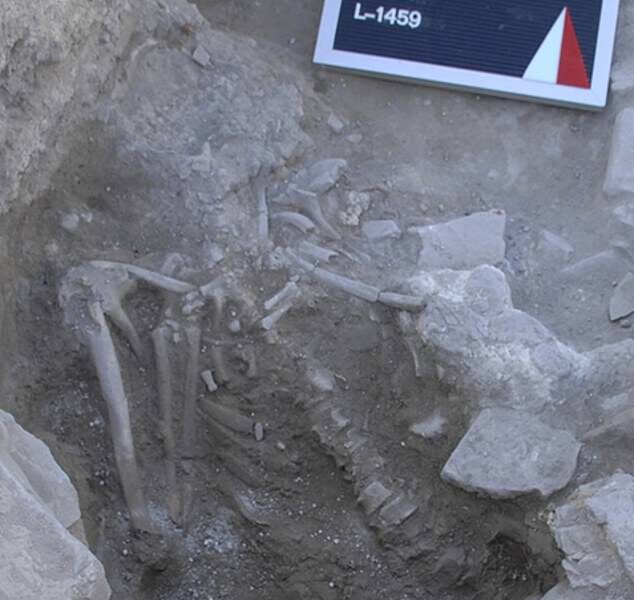Archeologists in the western coast of modern day Turkey (ancient Greek Ionia) have discovered the skeletons remains of a young man and dog, who were killed by a tsunami triggered by the eruption of the Thera volcano on the island of Santorini 3,600 years ago reports the Daily Mail.
According to the news report, Archaeologists found the pair of skeletons during excavations at Çeşme-Bağlararası, a Late Bronze Age site near Çeşme Bay, on Turkey’s western coastline.
“Despite the eruption of Thera being one of the largest natural disasters in recorded history, this is the first time remains of victims of the event have been unearthed.
“Moreover, the presence of the tsunami deposits at Çeşme-Bağlararası show that large and destructive waves did arrive in the northern Aegean after Thera went up.
“Previously, based on the evidence available, it had been assumed that this area of the Mediterranean only received ash fallout from the eruption of Thera.
“Instead, it now appears that the Çeşme Bay area was struck by a sequence of tsunamis, devastating local settlements and leading to rescue efforts.
“Thera — now a caldera at the centre of the Greek island of Santorini — is famous for how its tsunamis are thought to have ended the Minoan civilisation on nearby Crete.”
RESOURCE | ABOUT IONIA
Ionia was an ancient region on the central part of the western coast of Anatolia in present-day Turkey, the region nearest İzmir, which was historically Smyrna. It consisted of the northernmost territories of the Ionian League of Greek settlements. Never a unified state, it was named after the Ionian tribe who, in the Archaic Period (600–480 BC), settled mainly the shores and islands of the Aegean Sea. Ionian states were identified by tradition and by their use of Eastern Greek.
Ionia proper comprised a narrow coastal strip from Phocaea in the north near the mouth of the river Hermus (now the Gediz), to Miletus in the south near the mouth of the river Maeander, and included the islands of Chios and Samos. It was bounded by Aeolia to the north, Lydia to the east and Caria to the south. The cities within the region figured large in the strife between the Persian Empire and the Greeks.
According to Greek tradition, the cities of Ionia were founded by colonists from the other side of the Aegean. Their settlement was connected with the legendary history of the Ionic people in Attica, which asserts that the colonists were led by Neleus and Androclus, sons of Codrus, the last king of Athens. In accordance with this view the “Ionic migration”, as it was called by later chronologers, was dated by them one hundred and forty years after the Trojan War, or sixty years after the return of the Heracleidae into the Peloponnese.
Ionia has a long roll of distinguished men of letters and science (notably the Ionian School of philosophy) and distinct school of art. This school flourished between 700 and 500 BC. The great names of this school are Theodorus and Rhoecus of Samos; Bathycles of Magnesia on the Maeander; Glaucus of Chios, Melas, Micciades, Archermus, Bupalus and Athenis of Chios. Notable works of the school still extant are the famous archaic female statues found on the Athenian Acropolis in 1885–1887, the seated statues of Branchidae, the Nike of Archermus found at Delos, and the objects in ivory and electrum found by D. G. Hogarth in the lower strata of the Artemision at Ephesus.
The Persian designation for Greek is Younan (یونان), a transliteration of “Ionia”, through Old Persian Yauna.[14] The same is true for the Hebrew word, “Yavan” (יוון) and the Sanskrit word “yavana”. The word was later adopted in Arabic, Turkish, and Urdu as well as in other places.


